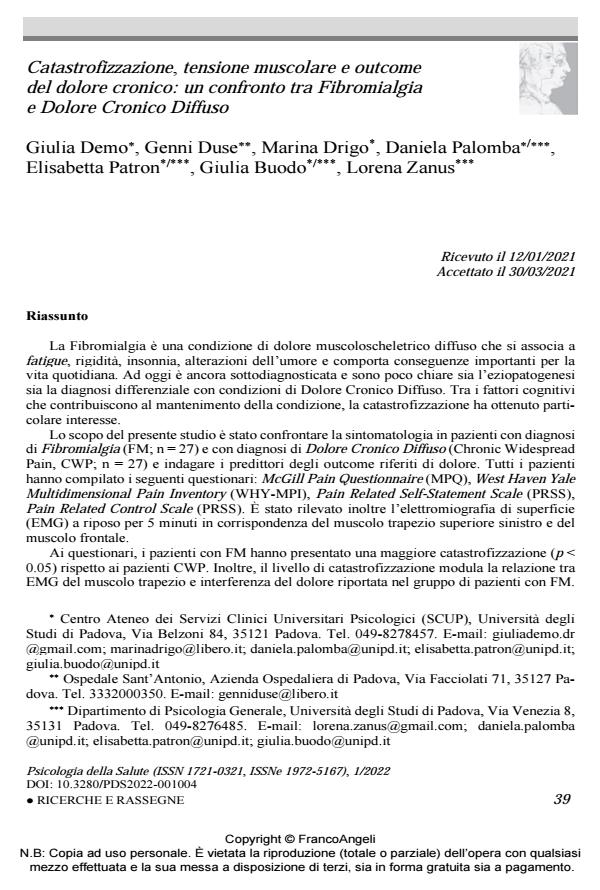Catastrophizing, muscle tension and chronic pain outcomes: a comparison between Fibrom-yalgia with Chronic Widespread Pain
Journal title PSICOLOGIA DELLA SALUTE
Author/s Giulia Demo, Genni Duse, Marina Drigo, Daniela Palomba, Elisabetta Patron, Giulia Buodo, Lorena Zanus
Publishing Year 2022 Issue 2022/1
Language Italian Pages 22 P. 39-60 File size 329 KB
DOI 10.3280/PDS2022-001004
DOI is like a bar code for intellectual property: to have more infomation
click here
Below, you can see the article first page
If you want to buy this article in PDF format, you can do it, following the instructions to buy download credits

FrancoAngeli is member of Publishers International Linking Association, Inc (PILA), a not-for-profit association which run the CrossRef service enabling links to and from online scholarly content.
Fibromyalgia is a condition of widespread musculoskeletal pain that is associated with fa-tigue, rigidity, insomnia, mood alterations. This syndrome has important consequences for daily life. Fibromyalgia is still underdiagnosed and both the etiopathogenesis and the differen-tial diagnosis are unclear, especially with other conditions of widespread chronic pain. Among the factors contributing to the maintenance of the condition, catastrophizing has gained particular interest. The aim of this study was to compare symptoms in patients diag-nosed with Fibromyalgia (FM; n = 27) and diagnosed with Chronic Widespread Pain (CWP; n = 27) and investigate the predictors of reported pain outcomes. All patients completed the following questionnaires: McGill Pain Questionnaire (MPQ), West Haven Yale Multidimen-sional Pain Inventory (WHY-MPI), Pain Related Self-Statement Scale (PRSS), Pain Related Control Scale (PRSS). The surface electromyography (EMG) at rest for 5 minutes was also detected in correspondence with the left upper trapezius muscle and the frontal muscle. On questionnaires, FM patients had greater catastrophizing (p <.05) than CWP patients. Furthermore, the level of pain catastrophizing modulates the relationship between trapezius muscle EMG and pain interference reported in the FM patient group. The results suggest that high levels of catastrophizing accentuate the negative effect of high levels of muscle tension in patients with FM.
Keywords: Fibromyalgia, Chronic Widespread Pain, chronic pain, catastrophizing, muscle tension
Giulia Demo, Genni Duse, Marina Drigo, Daniela Palomba, Elisabetta Patron, Giulia Buodo, Lorena Zanus, Catastrofizzazione, tensione muscolare e outcome del dolore cronico: un confronto tra Fibromialgia e Dolore Cronico Diffuso in "PSICOLOGIA DELLA SALUTE" 1/2022, pp 39-60, DOI: 10.3280/PDS2022-001004